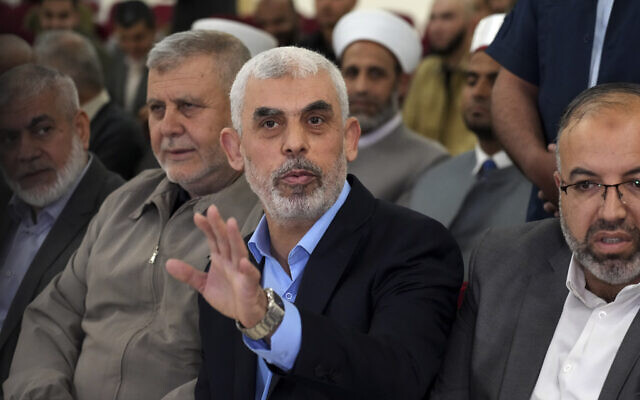



The Israel Defense Forces said Thursday it was working to confirm that one of three terrorists its forces had killed in Gaza was Hamas terror chief Yahya Sinwar, as a senior Israeli official said it was very likely that a body found at the scene was that of the October 7 mastermind.
The official said that the security establishment assesses that there was a “high likelihood” that the terrorist killed by the IDF was Sinwar.
“At this time, the identity of the terrorists cannot be confirmed,” the IDF said in a statement.
The terrorists were killed when troops opened fire on a group of combatants on the ground floor of a Gaza building in an incident that began on Wednesday. When the soldiers subsequently entered the building, they realized that one of the dead terrorists “looked very much like” Sinwar.
The army noted that there were no hostages present in the area where the three terrorists were killed. There have been reports that Sinwar has been hiding among hostages throughout the war, using them as human shields.
“The IDF and Shin Bet forces operating in the area continue to operate under the necessary caution,” the army said.
The military issued the statement after rumors relating to the incident began spreading widely online.
Unverified photos circulating on social media (Warning, link contains graphic images) appeared to show a body that resembled Sinwar.
According to reports, officials believed with high certainty that the body was that of Sinwar, but it was anticipated that a firm identification would take a number of hours.
The reports said the three bodies had been taken for DNA testing and would also undergo dental and fingerprint checks. Israel has both Sinwar’s fingerprints and dental records from his time in prison.
The leader of Hamas in Gaza since 2017, Sinwar is widely considered the architect of the October 7, 2023, invasion and massacre in southern Israel, in which thousands of Hamas-led terrorists killed some 1,200 people and took 251 hostage, sparking the ongoing war in Gaza.
The terror chief became leader of Hamas after the killing of Ismail Haniyeh in a Tehran blast in July, when he was selected by Hamas’s 50-strong Shura Council, a consultative body composed of officials elected by Hamas members in four chapters: Gaza, the West Bank, the diaspora and security prisoners in Israeli jails.
Born in the Khan Yunis refugee camp in southern Gaza, Sinwar joined Hamas when Sheikh Ahmed Yassin founded the group around the time the first Palestinian intifada began in 1987.
Sinwar set up the group’s internal security apparatus the following year and went on to head an intelligence unit dedicated to flushing out and mercilessly punishing — sometimes killing — Palestinians accused of providing information to Israel.
According to a transcript of an interrogation with security officials published in Israeli media, Sinwar — the “butcher of Khan Younis” — professed to have strangled an alleged collaborator with a keffiyeh in a cemetery in that city.
A graduate of the Islamic University in Gaza, he learned perfect Hebrew during his 23 years in Israeli jails.
He was serving four life terms for the killing of two Israeli soldiers, as well as four Palestinians he suspected of cooperating with Israel, when he became the most senior of 1,027 Palestinian security prisoners released in exchange for kidnapped IDF soldier Gilad Shalit in 2011.
He had received life-saving brain surgery while he was a prisoner, as recounted by the dentist who identified the tumor in a New York Times article in May. That same dentist’s nephew was killed on October 7.
Sinwar reportedly recently renewed contact with mediators for a potential hostage-ceasefire deal after weeks of silence that had stirred speculation he might have been killed in an Israeli strike in Gaza.
In February, the IDF released footage of what it said was Sinwar walking through a Gaza tunnel with several of his family members.
“The hunt for Sinwar will not stop until we catch him, dead or alive,” IDF Spokesman Daniel Hagaeri said in a press conference upon releasing the footage.
Earlier, in an apparently separate incident, the military said it carried out a precision airstrike against Hamas and Palestinian Islamic Jihad terrorists operating a command and control room from a building formerly used as a school in northern Gaza.
The IDF named 12 terrorists who were present at the Abu Hassan School, adding that they were involved in launching rockets at Israel and attacks on troops.
The military said it took steps to limit harm to uninvolved citizens in the strike.
At least 19 Palestinians including children were killed in the strike, an official from the Hamas-run Gaza health ministry told Reuters. The terror group’s figures could not be verified and do not differentiate between civilians and combatants.
Dozens were also injured in the strike, said the official, Medhat Abbas, adding: “There is no water to extinguish the fire. There is nothing.”
Separately, the IDF said troops found a chalkboard with statements written by terrorists praising the October 7 massacre in a classroom during its ground incursion in northern Gaza’s Jabaliya.
Troops in the 401st Brigade have eliminated dozens of terrorists through airstrikes and close-quarters urban combat since the incursion began earlier this month, the military said, releasing footage of the strikes.
In the raid of the school, troops found dozens of weapons, explosives, mortars, and ammunition.
The war in Gaza was sparked by Hamas’s onslaught on October 7, 2023. Israel’s counteroffensive has killed more than 42,000 Palestinians, according to the Hamas-run health ministry. The figure cannot be verified and does not distinguish between civilians and combatants. Israel said it had killed some 17,000 combatants in battle as of August, and another 1,000 terrorists inside Israel during the October 7 onslaught.



